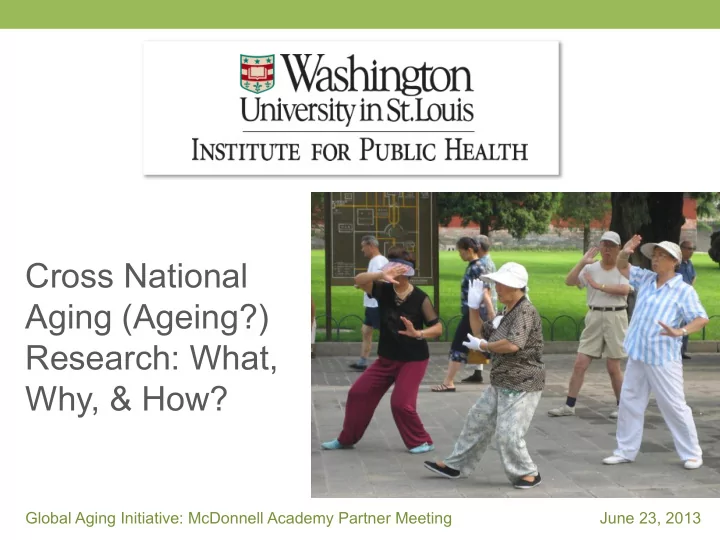

Cross National Aging (Ageing?) Research: What, Why, & How? Global Aging Initiative: McDonnell Academy Partner Meeting June 23, 2013
What? § Comparative or cross-national aging research is: − Investigation in TWO or more societies, cultures or countries compared with respect to the same underlying concepts, units of analysis − Intended to explain, compare, contrast, and generalize across population aging experiences. § Comparative research can be − Descriptive − Evaluative − Analytic “ … The expectation is that the researchers gather data about the object of study within different contexts and, by making comparisons, gain a greater awareness and deeper understanding of social reality ” Hantrais and Managen (1998)
Why and Why Now?
World Population Pyramids 1950-2100 United ¡Nations, ¡Department ¡of ¡Economic ¡and ¡Social ¡Affairs, ¡Population ¡Division ¡(2011) ¡
Global Population Increase Projected increase between 2005 and 2030 by age Source: United Nations. (2005). World Population Prospects.
Speed of Population Aging Number of years for population age 65+ to increase from 7% to 14%
The Moment “ There is a need to raise awareness about not only global aging issues but also the importance of rigorous cross- national scientific research and dialogue that will help us address the challenges and opportunities of an aging world. ” U.S. National Institutes of Health
Why: Potential and Promise of Cross-National Research § Understand global aging in its own right § Address basic gerontology questions − What aspects of aging are universal while other aspects are nationally or culturally specific? § Compare performance of systems, policies, interventions § Produce studies that cross traditional social science, biological science, public health boundaries § Exploit the “ natural experiments ” in other contexts § Produce ideas, innovations, “ tech transfer ” § Ask and answer “ Big Questions ”
Why is Comparative Research So Hard to Do? § Concepts of aging themselves § Language Excessively narrow § Traditions of theory, and over simplified? methodology, values, even ideology Plagued by unique § Scientific literature – measurement problems? what we read § Data § Time and Incentives Hard to draw causal implications? § Criticisms, status § Resources
Methodological Considerations § Reliability and quality of data § Non-equivalence of key concepts – often in variables and measures: ADLs § Translation problems § Matching of samples § Timing of data collection § Comparability of research instruments § Harmonization of secondary datasets
Best Practices for International Teams § Invest time to build common understanding § Meet face-to-face § Maximize technology and opportunities for communication § Assess shared passion and interest in research topic § Invest in the process of team development § Have open-mindedness, patience, a sense of humor § Find a common platform: data, a class to teach, a conference to attend § Have a goal: a paper to write, a grant to seek, a deadline. § Have fun.
Key Domains: McDonnell Partnership Age Friendly Caregiving Design & Community Managing Long-term Work & Chronic Care Retirement Conditions Health & Social Service Delivery Economic Social Security Participation
Examples for Us Examples for Us
My Hopes For Our Conference § Get to know each other and our work! § Identify key domains where we can collaborate on CNAR? Produce collaborative teams and proposals for funding. § Create a comparative aging data team? § Create a comparative policy research team? § See if there is a “ Big Think ” paper on the challenges of global aging? § Advise us on programs, web, students, other infrastructure for this initiative.
Next Steps “ the optimum way to develop both the research agenda and the data needed to address the economic and social issues associated with an aging world is through ongoing interaction among multidisciplinary national scientific communities ” – National Academy of Sciences
Resources: Examples of Cross-National and National Aging Datasets § Data sets funded by the National Institute on Aging: United States: Health and Retirement Study (HRS) 1. English Longitudinal Study of Ageing (ELSA) 2. Survey of Health, Ageing, and Retirement in Europe (SHARE) 3. Mexican Health and Aging Study (MHAS) 4. Korean Longitudinal Study of Aging 5. International Database on Aging (involving 227 countries) 6. International Network for the Demographic Evaluation of 7. Populations and Their Health (INDEPTH, involving 19 developing nations) Human Mortality Database (involving 28 countries) 8. World Health Organization (WHO) Study on Global Ageing and 9. Adult Health (SAGE) (involving 6 countries) 10. Chinese Longitudinal Healthy Longevity Survey 11. Longitudinal Study of Aging Danish Twins
Resources: Funding Sources § There are many funding sources available from governments, foundations, and corporations. Within the United States, a few funding opportunities are: − National Science Foundation: Catalyzing New International Collaborations (CNIC) − NIH/NIA: Regional and International Differences in Health and Longevity at Older Ages (R01, R21) − Fogarty International Center − WU Global Aging Initiative Seed Funding
Recommend
More recommend